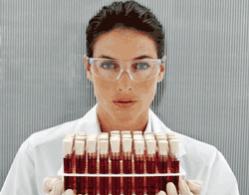 The odds have always been against the researchers with the guts or commitment to take ME/CFS on. With it’s unfortunate name, vague definition and complicated, multi-systemic nature it’s gotten little respect and even less funding. Everybody knows the statistics – last in the NIH in funding….$20 billion in economic losses and easily, easily the lowest dollar spent per patient. If any disease needs a ‘leg up’ in the research world this one does.
The odds have always been against the researchers with the guts or commitment to take ME/CFS on. With it’s unfortunate name, vague definition and complicated, multi-systemic nature it’s gotten little respect and even less funding. Everybody knows the statistics – last in the NIH in funding….$20 billion in economic losses and easily, easily the lowest dollar spent per patient. If any disease needs a ‘leg up’ in the research world this one does.
With so many still major unresolved issues we need to get the best bang for each limited buck that we have. Basically we need to put one input in and get 10 or twenty or fifty in return.
The CFIDS Association has just tossed an ambitious project in the ring that can turn pennies into dimes and nickels into dollars. The Patient BioBank project will take samples from carefully characterized ME/CFS patients and then bank them for future researchers to use. It has the potential take one rigorously defined ME/CFS sample and turn it into ten. A patient who donates to the bank today could help solve CFS 10 years from now.
Since researchers won’t have to scramble for samples the BioBank will help them cut their costs substantially – a big relief for the many innovative but financially strapped small research groups that permeate the field. This means more studies, and perhaps most importantly for patients, quicker study turn around’s (and fewer half decade long studies that go on and on while patients wilt away).
That Special ‘CFS’ Patient – In a welcome move the CAA is changing the rules on how to define a ‘CFS’ patient in its first BioBank Project. To have priviledge of being one of the first ones in you must have post-exertional malaise (a first in the research world) and to be diagnosed using the Fukuda or the Canadian Consensus Criteria. Patients who meet the Canadian Criteria or who have abnormal natural killer cell results will get in first.
The First Study – a collaboration between four ME/CFS physicians and Smith Glaxo-Kline will attempt to find XMRV in the most WPI-like patient cohort put together since the big XMRV paper came out in the Science journal. All participants will also have to have acute onset making this one of the most CFS-like group of patients ever gathered for a study – something patients and researchers have waited for over 20 years to have happen.
Enhancing Creativity – The BioBank should also enhance creativity at the research level. The NIH and CDC are more known for the things that they don’t research than the things that they do. Getting an innovative research proposal through a federal review panel composed of dentists and pain specialists is ridiculously difficult. Those XMRV grant proposal failed to cut the mustard. The repeat exercise metabolic study grant didn’t have a chance. That study examining the immune status of patients as they became ill bombed. We could go on and on. Many of the most innovative research proposals get their legs knocked from out of them at the federal level.

SolveCFS Biobank – The fact is that if we want non-mainstream, really innovative, out of the box type studies that could blow the lid off of ME/CFS they’re probably come from places like the CFIDS Association of America, the Whittemore Peterson Institute, MERUK and other ME/CFS groups. These groups can’t afford the kind of big, lumbering, half a decade encompassing studies the NIH specializes in but they do specialize in agile, innovative studies that pinpoint a target and sneak behind the traditional lines of research to blow it up, hopefully creating enough light and heat in the process to get the rest of the research world’s attention. (Note how well that worked with the WPI, XMRV .…and their BioBank. )
The groups using the BIoBank are not going to be the one’s doing the 25th cortisol study; that’s for the UK and CDC researchers to do. They’re going to be snuffing out unusual viruses ( eg XMRV) or determining if CFS patients guts are teeming with bad microbes (CFID’s Association) or if a nitric oxide -blood vessel -gut – mitochondria in the brain connection (CFID’s Association) is present. They’re the ones we need to have succeed and they’re the ones the BioBank is going to welcome with open arms. They are also the ones that desperately need a BioBank to be successful.
If this bank succeeds it will reap a dividend for the ME/CFS community for years to come. It will make ME/CFS research easier, cheaper and faster – something we all desperately need.
Spending Money to Save Money – Research, even done wisely, however, is never cheap and the BioBank is no exception. It will cost the CFIDS Association $20,000 a year in dues. Each sample banked will add another $450 to the CFID’s Association’s bill. The Biobank is an expensive proposition for the CAA but when you’re turning a sample over many times – when you’re able to probe a single sample for its gene expression/ immune status/oxidative stress levels/ hormone levels/(take your pick) then that $450 shrinks and shrinks and shrinks.
If you want innovative research this is a project to support. If you want to take the bull by the horns rather than wait for the feds to finally decide this is a real disease – this is a project to support. This is where CFS researchers (rather than dentists on a CFS review panel in DC) finally begin to take command of the research agenda .
